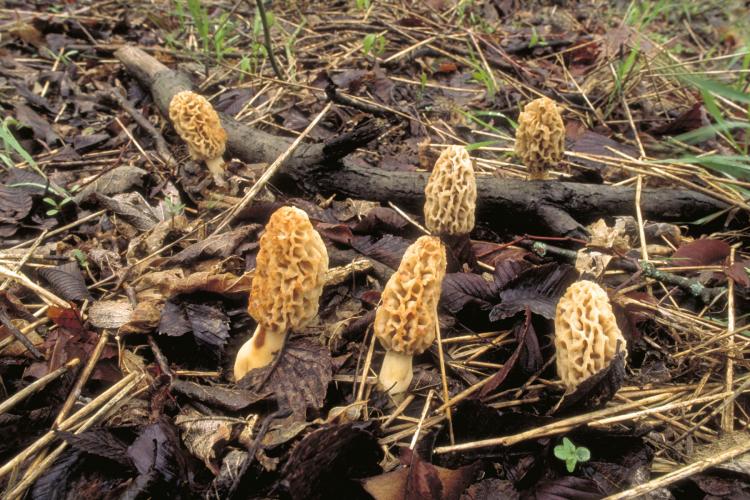There might not be a season Ohio foragers enjoy more than morel mushroom season. From now until the middle of May, morel mushrooms will be emerging along the edges of forests, throughout old apple orchards and in locations where there was a forest fire the previous year.
They prefer loose soil that’s rich with humus, high humidity and decaying vegetation such as rotting fallen trees and stumps, especially, rotting elm, cottonwood, ash, aspen, oak and tulip poplar trees.
Incidentally, their toxic and inedible look-a-likes thrive in a lot of the same conditions. Foragers should be careful not to confuse true morels with similar-looking species that can cause illness or possibly even death. Foraged foods, including wild mushrooms, should never be consumed unless they’ve been identified as safe and edible.
Identifying morel mushrooms

Caps. Morel mushrooms feature distinct pitted caps with an irregular honey-combed or spongelike appearance. Yellow morels have pale ridges with darker pits and black morels have dark ridges with paler pits. Their caps can be conical, egg-shaped, elongated with a rounded top or nearly spherical.
Stems. Morel mushroom stems are unpitted with a smooth or granular texture. They are often crumbly or brittle with no ring. They can be whitish, cream-colored or yellowish. They can have a round, slightly flattened or irregular cross-section profile. They often appear to be creased or folded at the base where the stem widens.
Inside. When sliced lengthwise, both the cap and stem are completely hollow with no cottony material inside. The hollow space inside is a continuous cavity, running seamlessly from the top of the cap to the base of the stem.
Size. Morel mushrooms typically range in size from 1-4 inches tall, depending on the variety. Yellow morels can reach much larger sizes at the end of the season.
Season. Spring.
Other characteristics. Half-free morels, which are less desirable than yellow and black morels, are the only variety to feature a short skirt around the lower half of the cap. However, there should never be a full loose skirt that hangs from the top of the stem — a defining characteristic of the netted stinkhorn.
False morels and other lookalikes
Several types of mushrooms with wrinkled caps that look similar to morels may appear in the woods during the spring.
Gyromitras, false morels
Caps. False morels have lumpy caps with a brain-like, folded or wrinkled texture. False morel caps can be black, grey, white, brown or reddish. Their cap surface differs from a true morel because they do not have pits and ridges. They bulge outward instead of being pitted inward.
Stems. False morels typically have stocky stems that can appear smooth or ribbed, depending on the variety. Their stems range in color from white to pale tan.
Inside. All false morels have pale, chambered flesh inside. They are not hollow.
Size. False morels are larger than morels on average, ranging in size from 3-7 inches tall and wide.
Season. False morels can be found at different times of the year, not just in spring.
Verpas
Caps. One form of Verpa mushroom features a wrinkled or lobed, pale yellow to brown cap that can appear similar to morel mushrooms. However, its cap is attached to the stem only at the top and its sides hang completely free.
Stems. Verpa stems are lightly colored and brittle.
Inside. Their stems are at least partially stuffed with soft cottony tissue. They are not hollow inside.
Size. They are similar in size to morels, growing 3-8 inches tall.
Season. Verpas are found earlier than morels and continue to grow during morel season.
Elfin Saddles
The color and form of mushrooms in this large genus vary, however, some species look like false morels.
Caps. Elfin saddles have caps that resemble saddles with lobes, folds, flaps or wrinkles.
Stems. Their stems are often ridged or fluted.
Size. They typically grow 4-6 inches tall.
Season. Summer through fall.


















Those article is garbage. You say false-morel and say they, as in ALL, are toxic when this is just not true to some under this outdated umbrella term!
You say Verpa, but not any of the species under this genus. Some, like V Bohemica, are considered edible when prepared correctly.
A lot of the species under the genus Gyromitra are edible, like G brunnea. G Caroliniana and G Esculenta are considered edible after proper preparation.
G. Esculenta was eaten for centuries in the Czech Republic.
You might want to do a little better research and actually know what your talking about before making garbage articles like this.
Matthew, thank you for providing additional information on this subject. This how to was mainly written for novice foragers, and leaned on the side of caution for those that are not as experienced as you. We don’t want to share information that could get anyone sick. The main goal was to stress the importance of being able to correctly identify morels this spring.
Sara keep up good work ! Great article for beginners . Haters will hate if people have nothing nice to say they should shut the f up!
Looking forward to more of what you have to share thank you
Thank you, Sara.
I’m going hunting for the first time tomorrow. I appreciate your advice!
Shellie, no problem! Happy hunting!
Sara-
We have morels and verpas here in Oregon and from your article, I just learned how to tell them apart!
Thank you!
Amber, thanks for sharing! Happy to help!
So I conclude that if the morel looking mushroom is hollow all the way from bottom to top, it’s safe. ?
Yes, Linda! They are delicious! If you get an abundance and wat to dehydrate them, do not do that in the house. The spores can cause lung problems. Do that on a porch or garage.
Sara,
Thank you for taking the time to share with us novices, very much appreciated.
Mickey Hudnall